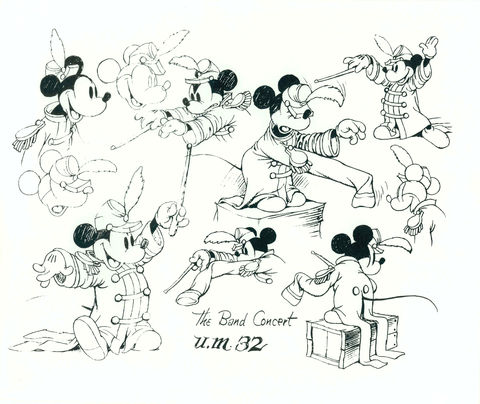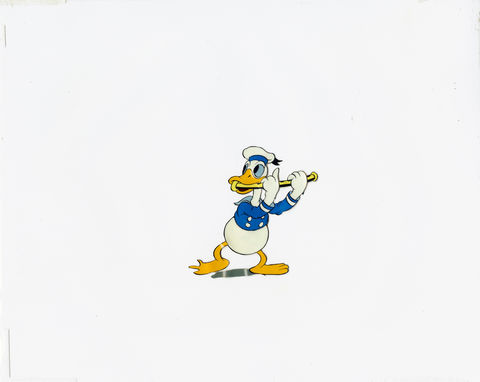Overture
The year is 1935. America is mid-way through the Great Depression. The Dust Bowl is devastating the prairies. A war-weary world, whether aware or not, is a few short years from one of its greatest crises. Mickey Mouse, a black-and-white cartoon icon, is about to face the music, in more ways than one.
Walt Disney innovated mightily in animation technology and techniques throughout the 1930s—including joining the Technicolor® revolution during production of Flowers and Trees (1932)—and would be rewarded with eight straight competitive Academy Awards® in the newly formed category of Best Short Subject (Cartoon), now known as Best Animated Short Film. This critical recognition was music to Walt's ears.
Three years after Flower and Trees, Disney tuned up its most famous 'toon, Mickey Mouse, with a defining color scheme in a landmark short film, The Band Concert (1935).

“Band Director” Wilfred Jackson
Despite his lack of formal experience relative to other Disney directors at the time, Disney Legend Wilfred "Jaxon" Jackson was a pitch-perfect choice for director on The Band Concert. Known for his work on music-oriented films, Jaxon’s understanding of music timing helped contribute to the synchronization of sound for Steamboat Willie (1928), Mickey’s debut film. Jaxon saw music and action as symbiotic elements of animated storytelling: "I wanted every part of my picture to be worked out in such a way that the music and action would enhance each other—not just the different elements running along parallel lines harmoniously, but a wedding of the two—a fusing of the two into a new thing that would become something more than just music plus action."
"Something more than just music plus action" is an apt description for what takes place in The Band Concert. Mickey plays a “mice-tro” leading an outdoor symphony into a segment of Rossini’s famous “William Tell” Overture, when food vendor Donald—loudly selling his wares—notices the ongoing performance, whips out his fife, and joins the recital. The band plays on. Through several of Donald’s fifes being destroyed, conductor Mickey’s control of the band being flouted, and Donald's outbursts by way of a tussle with a wayward bee, the band is completely focused on the music, unaware of an oncoming tornado. The band plays through the L. Frank Baum-esque gale, landing in humorous positions on and near a tree as they conclude their performance.
The cyclone gag is so effective because director Jaxon understood the importance of set-up and payoff, saying about this scene: "I believe that if you came into the theater at the time the cyclone was first picking them up, you wouldn't get a laugh. It built up from the first of the picture. That mood—that the musicians in the band would play 'William Tell' in spite of anything—carried through the picture had a lot to do with it being a funny spot towards the end."
Mickey Mouse Shorts Get Their Signature Color
The Band Concert was key in establishing a key detail about Mickey’s clothing. To that point, Mickey’s shorts had been both red and green, but from The Band Concert onward, Mickey’s signature color was definitively red. It's not only the color of Mickey's clothes that would make a return, but a gag related to the clothes themselves: Mickey comedically struggles with his oversized robe in The Band Concert, a joke that would be renewed in another prominent musical Mickey venture, "The Sorcerer's Apprentice" segment in Fantasia (1940)—released just five years later. It seems like Mickey could’ve benefitted from taking his robes to a…brave little tailor.

Donald Duck Takes Center Stage
Mickey’s not the only character headlining The Band Concert, either. In addition to Mickey's aesthetic changes, the short film was an example of Donald's increasing popularity stock. The duck tooted his own horn—or fife, rather—and stole the show, as noted by cultural critic Gilbert Seldes: "There have been signs that the impudence and cockiness of the Mouse were dwindling, that Mickey was going polite. In The Band Concert the duck takes over. It is a bad, wicked duck, a malicious and mischievous duck, a duck corresponding to all the maddening attractiveness of bad little boys and girls—a superb character."
During the 1930s, side characters who premiered in Silly Symphony short films like Donald, Goofy (also cast as a band member), and Pluto, were becoming popular stars in their own right. This was owed at least partially to the fact that Disney animators found Mickey to be a more limiting character to write for, one studio writer claiming "we can whip out three Donald Duck stories in the time it takes us to work out one for the Mouse." Donald would continue to march to the beat of his own drum throughout the 1930s and 1940s, including in the standout feature films Saludos Amigos (1943) and The Three Caballeros (1945), becoming an easily agitated avian ambassador from Disney to the world in the process.
Standing Ovations for The Band Concert
The Band Concert is largely considered to be one of Mickey’s finest, a short film that Walt himself—in an interview with journalist Pete Martin of the Saturday Evening Post—said “made quite a hit.” New York Times Magazine’s L.H. Robbins, reflecting on Mickey’s stardom, mused: “How has an imaginary creature only 6 years old, going on 7, captured the interest of almost every tribe on this terrestrial ball?” Notable conductor Arturo Toscanini, leading the New York Philharmonic at the time, reportedly watched it six times and even invited Walt to visit him in Italy. Toscanini’s countrymen agreed, bestowing on the film the 1935 Venice Film Festival Gold Medal winner for Best Animation. Film critic and historian Leonard Maltin called the film “the best Disney cartoon short”; and cultural critic Gilbert Seldes in Esquire referred to it as “Disney’s greatest single work,” doubting aloud “whether half a dozen works produced in America at the same time in all the other arts can stand comparison with this one.” Extending its legacy, the short film and its iconic music have made numerous appearances in Disney theme parks, video games, and compilation theatrical films and home video releases.
Ultimately, The Band Concert proved to be a test case for the future direction of Disney short films: a test of adding Technicolor to the most famous black-and-white cartoon mouse of all time, making Disney the first all-color cartoon studio; a test of the capabilities of a young director producing for a household name; and a test of an up-and-coming supporting cast including a flourishing fowl. A test that the Disney team passed with flying colors. And instruments.

–Chris Mullen, Marketing and Editorial Specialist
Image sources (in order of appearance):
- The Band Concert (1935) cel set-up on display in Gallery 3 of The Walt Disney Family Museum; collection of the Walt Disney Family Foundation; © Disney
- The Band Concert (1935) cel, Donald Duck with flute; collection of the Walt Disney Family Foundation, Gift of Ron and Diane Miller; © Disney
- The Band Concert (1935) U.M. 32 model sheet; collection of the Walt Disney Family Foundation; © Disney
